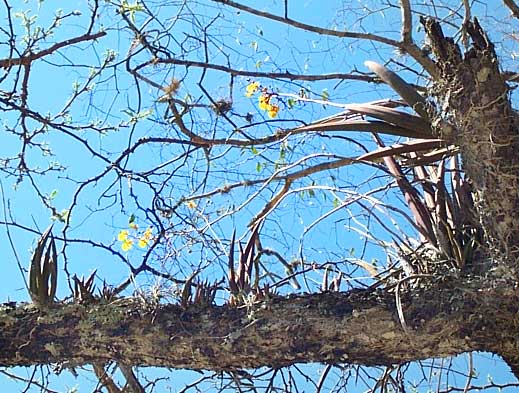Excerpts from Jim Conrad's
Naturalist Newsletter
from the March 24, 2007 Newsletter issued from Sierra Gorda Biosphere Reserve, QUERÉTARO, MÉXICO
ONCIDIUM ORCHIDS FLOWERING
The Reserve's Management Program book lists 38 orchid species for the reserve, and surely there are several more. What a pleasure it is to find any of the 38 blooming in its native habitat.
I've been waiting for the one that began flowering last week, for it is common and conspicuous on trees next to the Reservoir. Because of its large leaves I knew that its flowers would be spectacular. You can see a small colony with their stiff, sharp-pointed, thick leaves up to 15 inches long, and nodding yellow flowers, clinging epiphytically with their white roots to the bark of a dry-season-leafless acacia tree below:

This is ONCIDIUM CEBOLLETA and you can see a nice close-up showing details of an individual flower on the OrchidWeb.Com website, where it's placed in the genus Trichocentrum.
In the labeled flower-photo at the above link, the large, yellow, butterfly-shaped thing is actually just a much-modified lower lip of the corolla. The bumps labeled "callus" are growths not directly associated with the sexual parts. Surely the callus's form and colors have evolved to fool pollinators into landing there, maybe to mate with the callus. The blossom's sexual parts lie in the flower's center surrounded by radiating, purple-spotted upper petals.
The genus Oncidium is a big one, the number of species in it depending on who your expert is. It's so complex that "splitters" want to divide it into numerous small genera but "lumpers" say it's just a huge genus and more species should be shifted to it. When you look at Oncidium taxonomy and remember that certain groups have been shown to evolve much faster than others, you start wondering about the whole classification system. I personally think the traditional kingdom/phylum/class/order/family/ system is inadequate and misleading.
Whatever their pedigree, Oncidiums are generally thought of as epiphytic orchids growing where dry seasons occur. Our O. cebolleta occurs from here and the West Indies south through Central America all the way to Paraguay, so it enjoys a distribution larger than most orchids. One website says that our species likes strong light and high humidity with a good airflow -- which is exactly what the ones in the photo have, the humidity supplied by the nearby lake and the airflow being great on that limb jutting out over the road.